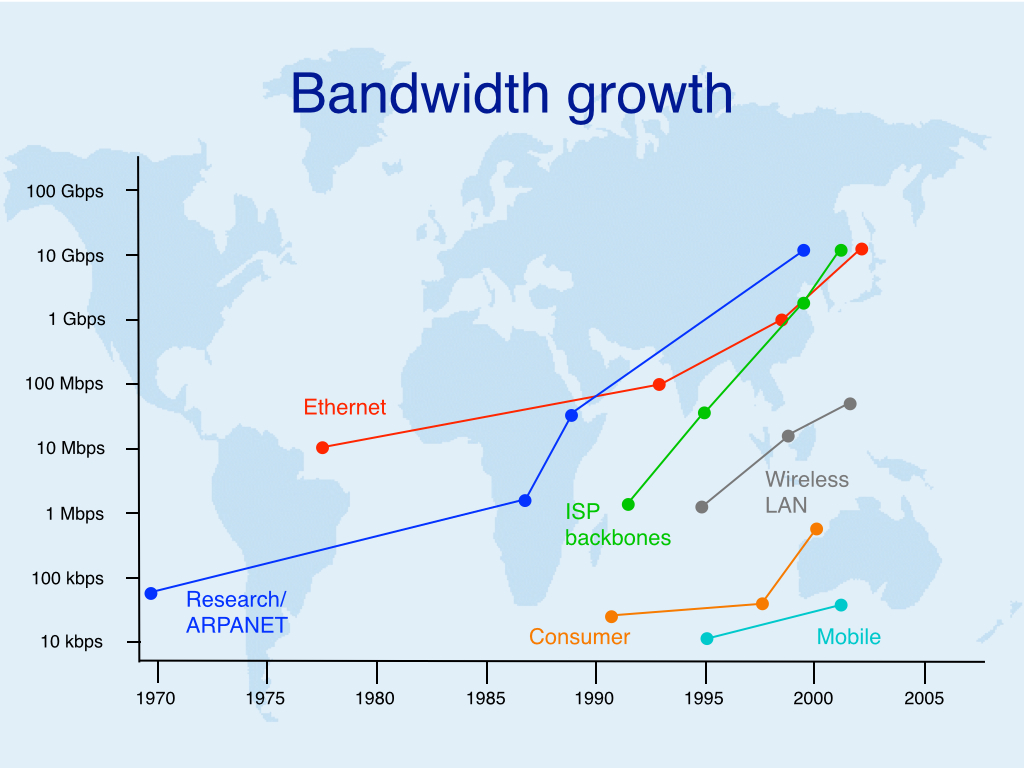►
Next week I'm doing a guest lecture about the infrastructure of the internet. Turns out that I already talked about that in 2003 (PDF). One slide in that presentation caught my eye:

The image shows how bandwidth in research networks and ISP networks has grown, as well as the bandwidth provided by technologies such as Ethernet, Wi-Fi, mobile data, and consumer internet access. All of them show a healthy growth, although some start from extremely modest beginnings.
So I wondered what happened in the intermediate decade...
Full article / permalink - posted 2014-09-04
▼
Next week I'm doing a guest lecture about the infrastructure of the internet. Turns out that I already talked about that in 2003 (PDF). One slide in that presentation caught my eye:

The image shows how bandwidth in research networks and ISP networks has grown, as well as the bandwidth provided by technologies such as Ethernet, Wi-Fi, mobile data, and consumer internet access. All of them show a healthy growth, although some start from extremely modest beginnings.
So I wondered what happened in the intermediate decade. Which would be:

Because research and ISP networks are so diverse, I didn't include these here. Of course this is all somewhat arbitrary, because few people use the highest available speeds. For instance, cable and fiber to the home internet access tops out at 100 Mbps or higher, but many people still use around 10 Mbps, either because of price or because they're limited to some form of DSL and a relatively long distance to the nearest telephone exchange. And LTE should be able to reach 300 Mbps, but I don't think that's available in commonly available handsets.
My impression that Ethernet had run out of steam is not entirely correct, the progression to 100 Gbps is roughly in line with the earlier growth path. Wi-Fi looks a little less impressive than I had thought on this logarithmic scale. However, there's just one super star here: mobile. It's hard to believe that we went from 100 kbps or so EDGE to 100 Mbps LTE in about a decade. Not everyone may be using LTE just yet, but 14 Mbps UMTS HSPA is in very wide use, there is really no reason to use anything less.
Permalink - posted 2014-09-04
▼
Yesterday I posted this to Twitter:
Kicking it old school while my iPhone 5 is undergoing battery surgery.

And then this morning I saw Andy Ihnatko had a video based on a similar photo, where he extolled the virtues of the 20-year-old versions of the technologies now bundled inside an iPhone: Why 2013 Won't Be Like 1993. (Part of his effort to decide once and for all whether doing video is for him by doing three a week for a month—recommended.)
And yes, the old stuff does have some advantages. As someone on Twitter mentioned: "i wish you a happy week with no need for recharging :-)" It's true, the Nokia 6310i from 2002 easily lasts a week on a charge. However, I think if you only use your iPhone for making a short phonecall a few times a week, it also lasts for many days... And the dead tree book doesn't need any power at all!
When I brought in my iPhone 5 at the Apple Store yesterday, they first tried to repair it in the store, but when I came back later they told me the repair was unsuccessful so they had to send the phone away, and it may be as much as two weeks before I get it back. They did give me a loaner 16 GB iPhone 5, though. Not easy to get everything into 16 GB (well, just over 12, really) when 32 GB (= just under 28) was already cramped before.
Permalink - posted 2014-09-02







